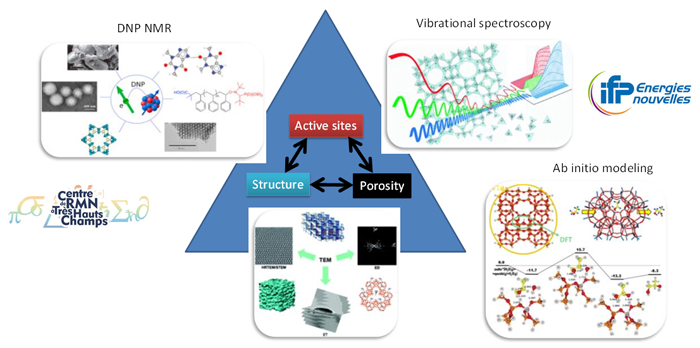
The aim of this research project is to study and monitor the morphological and structural transformation of zeolites during the industrial treatments that are applied to obtain highly active catalysts in refining, petrochemistry, decontamination or biomass-conversion processes.
Innovative approaches providing new insights
To achieve this, innovative spectroscopy and microscopy approaches will be used. The analysis of the results will contribute to the development of state-of-the-art theoretical calculations.
In particular, the implementation of ex situ and in situ analytical methodologies will provide new insights on the different steps of the structural modification of zeolite crystals during pore nucleation and growth processes, linked to the migration of aluminium atoms induced by heat or chemical treatment.
These studies will provide clues to unravel the complex relationships between experimental real-time observations of the structure/localization of acidic sites, fine morphological changes and the catalytic activity of zeolites.
This will in turn lead to a rational understanding of their physicochemical stability and improve their catalytic function.
LCR CARMEN aims at developing synergies between several teams that are at the forefront of their respective research fields, concerning the characterization and understanding of the properties of functional materials for heterogeneous catalysis.
An interdisciplinary study of zeolitic materials
In the field of mesoporous materials, CARMEN will focus its research on zeolite materials, in particular on the relation between their structure, textural and chemical properties (see figure below).
A multi-disciplinary approach will be developed at CARMEN by considering the expertise in:
- heterogeneous catalysis (IFPEN, Lyon);
- ab initio modeling (IFPEN, Lyon-Rueil);
- high-resolution solid-state NMR spectroscopy (CRMN, Lyon);
- electron microscopy (IPCMS,Strasbourg)
A research strategy based on a strong complementarity
The research strategy is focused on producing state-of-the-art data from these different approaches, based on a unique set of samples and an ambitious model of complementarity.
The different techniques have their own specific spatial and time characterization scales, sample environments and statistical relevance, and often bridges are not built between them.
Building bridges between techniques
The research strategy will therefore focus on building and consolidating these bridges, capitalizing on overlaps and complementarities between the different techniques.
Ab initio modelling
Ab initio modelling will play a structuring role thanks to the implementation of a modelling strategy at different scales. These will enable us to understand transformations and chemical properties at the atomic scale (relation between structure-chemistry), as well as at larger scales, such as the pore diameter, the crystal surface or the edges of structural defects (relation between texture-chemistry).
Electron microscopy
For each characterization technique, the aim is to achieve a new observational insight of the zeolites. Electron microscopy will be used to provide a dynamic in-situ description of mesopore formation, in combination with a detailed ex-situ characterization of the chemical and structural transformations of zeolites.
This microscopic insight will generate dynamic morpho-structural models and which are fundamental in order to be able to correlate the main findings with the results obtained by ab initio modelling.
NMR
Solid-state NMR spectroscopy will be taken to an unrivalled level of sensitivity for this type of material through high-field hyperpolarization techniques. It will make it possible to describe the acidity of the zeolites at a level of detail close to that modelled by DFT calculation, and thereby to validate some key hypotheses regarding the chemical environment of different types of acidic sites.

Schematic diagram of the interactions between the Institutes involved in LCR CARMEN, their expertise and techniques and the properties studied in the zeolite materials targeted by CARMEN's "Mesoporous Materials" research.
Choice of materials: faujasite and ZSM-5
Two industrially-relevant zeolite materials with different cage and channel topologies have been selected, namely Faujasite and ZSM-5.
The subject of the research is the focus on a thesis project (Valentina Girelli Consolaro) and two post-doctoral projects:
- the thesis project will be conducted principally at IPCMS and will focus on electron microscopy studies during a period running from 2020 to 2023;
- the first post-doctoral project will be devoted to the development of NMR techniques, managed by CRMN during an 18-month period between 2020 and 2022;
- the second post-doctoral project will be devoted to ab initio calculations, managed by IFPEN in 2021.
ANR funding
The CARMEN consortium may extend depending on opportunities, for example within the framework of ANR- or Europe-funded research projects. Notably, the ZEDET draft proposal has successfully cleared the first round of assessments for the ANR 2019 Call for Projects, and is now being prepared for the second round of assessments.
This project aims to support part of the actions initially planned and also includes an additional component concerning the in-situ IR-ATR analysis of acid attacks of zeolites at the Catalysis and Spectrochemistry Laboratory (LCS) in Caen.
